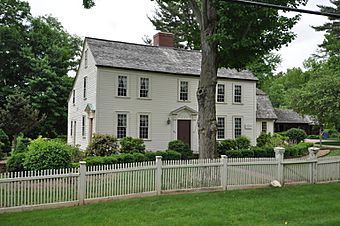King's Field House facts for kids
Quick facts for kids |
|
|
King's Field House
|
|
 |
|
| Location | 827 North St., Suffield, Connecticut |
|---|---|
| Area | 9.7 acres (3.9 ha) |
| Built | 1723 |
| Built by | King, Lt. William |
| NRHP reference No. | 82004440 |
| Added to NRHP | March 11, 1982 |
The King's Field House is a really old and special house located in Suffield, Connecticut. It was built way back in 1723, which means it's almost 300 years old! This house is a great example of how homes looked in the 1700s. Because it's so important, it was added to the National Register of Historic Places in 1982.
Contents
What Does the King's Field House Look Like?
The King's Field House is found in a quiet area north of Suffield's town center. It's a two-and-a-half story house made of wood. It has a pointed roof and a chimney right in the middle. The outside is covered with overlapping wooden boards called clapboards.
The Saltbox Shape
One cool thing about the house is its shape. The back roof slopes all the way down to the first floor. This gives the house a classic "saltbox" look. Imagine an old wooden saltbox; that's where the name comes from! There's also a newer part added to the back of the house.
Inside the Historic Home
When you step inside, you can see how the house changed over time. The wooden beams that hold the house up are from the 1720s. Later, some rooms, like the parlors (living rooms), were decorated with fancy wooden panels. Even the front door area was updated in the late 1700s with a special design that looks like a fan.
Who Lived in the King's Field House?
The house was built around 1723 by Lieutenant William King. His father, James King, was one of the very first settlers in Suffield. William King received the land around the house in 1722.
A Family of Leaders and Workers
William King was a big landowner in the area. He was also very active in town government, serving as a "selectman" for many years. A selectman is like a town council member who helps make important decisions for the community. Later generations of the King family also lived in the house. They ran different businesses, like a blacksmith shop (where they worked with metal) and a cooperage (where they made wooden barrels).
Restoration by a Pioneer Woman
In the 1930s, the house was carefully fixed up and restored. This work was done by Delphina Clark. She was a very special person because she was the first woman ever allowed to study at the Yale School of Architecture. She even lived in the King's Field House for a time!



